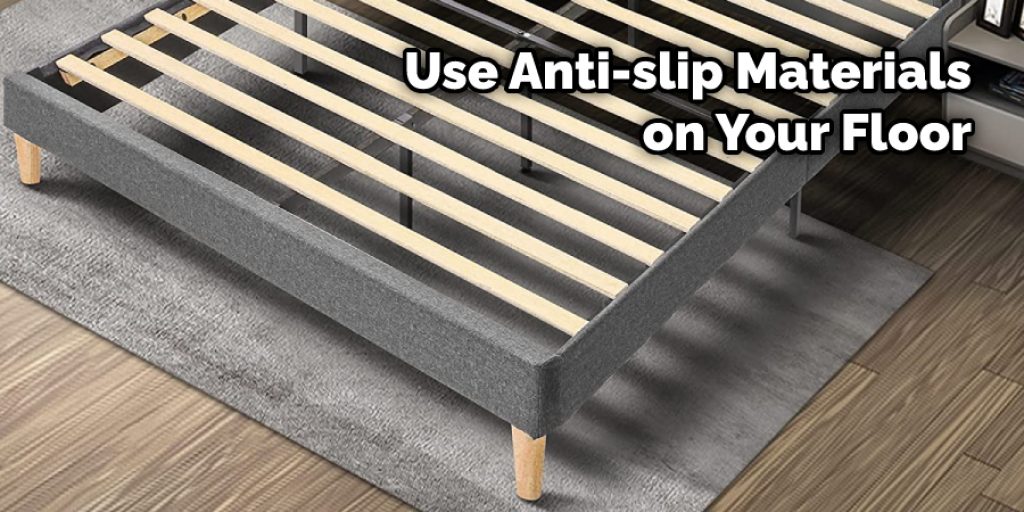How to Stop Bed Frame From Rolling
Do you have a bed frame that always seems to roll away from the wall? Or maybe it’s so wobbly, and you’re afraid it might fall over at any moment? Unless you have a bed frame with anchoring screws or bolts, your frame is prone to sliding across the room often during the most inconvenient times. If so, then this blog post is for you.

If your bed frame is constantly rolling, follow these tips to stop it from moving. By using some simple techniques, you will be able to keep your bed in place and get the sleep that you need. In today’s post, we’ll be discussing how to stop bed frame from rolling or wobbling. So whether you’re looking to stabilize your current bed frame or are in the market for a new one, keep reading!
10 Ways on How to Stop Bed Frame From Rolling
1. Adjust the Bed Legs
The wheels on your bed frame can be adjusted to make it tighter or looser, depending on your needs. If the wheels are too tight and won’t roll, try loosening them slightly to see if that helps.
2. Add Weight to the Wheels
If your bed frame still keeps rolling across the floor, you can try adding some weight to each wheel. This should help it stay in place so that you don’t have to worry about moving around as you sleep or get into or out of bed. You can put something heavy on the wheels, like a brick or cinder block. You can also try wrapping some heavy chains around each wheel for extra weight.
3. Add Rubber Stoppers to the Legs
You can keep your bed from rolling on most surfaces by adding rubber stoppers to your bed frame. This is especially helpful if you have carpeted floors. Place the rubber stoppers underneath each leg of your bed to keep it from sliding around. You can buy these at most hardware stores or home improvement centers, making them fairly easy to find and replace if they wear out or get lost.
4. Add an Anti-slip Material

Using anti-slip materials on your floor will help to keep your bed frame from moving. This is typically a self-adhesive material that will not damage the floor or leave any residue when peeling it away from the surface. You can find this in most hardware stores, especially if you are looking for anti-slip strips for your bathtub, shower flooring, etc.
5. Add a Rug
Using a rug under your bed frame will help to keep it from rolling around. If the wheels are rubbing against the carpet, this could be what is causing them to move as you rest or sleep. Putting a rug down should give you enough traction so that your bed frame cannot move independently.
6. Use Velcro Strips
If you are willing to spend a few extra dollars, you can purchase special strips that will adhere to the legs of your bed frame. These are known as Velcro strips and should help your bed stay in place even on carpeting or other surfaces where it could roll around easily without them.
7. Use Double-sided Tape
You can also use double-sided tape to keep your bed frame from rolling. This may be a better option for people who cannot get anti-slip strips to stick to their floorings, such as those with hardwood floors or tiles. The double-sided tape should attach securely to the feet of your bed frame and help it stay in place even if it is on a slippery surface.
8. Place a Board Under the Legs
Inserting a wooden board under each corner of your bed can help prevent it from rolling around. You will have to lift your bed carefully and insert the board underneath before releasing it back into an upright position. This should be helpful for those who need to lift their entire bed instead of just the legs.
9. Lubricate the Feet

Another option is to apply lubricant to the feet of your bed frame. This will help it slide across surfaces such as carpet or tile instead of rolling around on its own. You can find special non-toxic commercial lubricants at your hardware store.
10. Apply Removable Adhesive Strips
Lastly, you may want to try applying removable adhesive strips to the feet of your bed frame so that it can’t roll around on its own. This is a temporary solution, but many people have succeeded. Remember that you will need to replace these strips once a month or so, depending on how often you move your bed.
You can also try applying non-slip material with adhesive backing (found in the paint section of most big box stores) to the legs of your bed frame to prevent it from moving.
Some Tips and Suggestions
1. Use a nonslip pad underneath the bed to prevent moving on hard surfaces.
2. If your mattress moves easily on the bed frame, you can try putting some felt pads on each corner of the frame. The corners of your frame may be more likely to scratch or damage your floor than the middle parts of your frame.
3. Ensure adequate support around the frame’s area connects to the headboard and footboard. For example, if you have a four-poster bed, it may be important to use center support braces between each leg for added stability.

4. Make sure that your bed frame dimensions match your mattress dimensions.
5. If the height of your bed allows for it, you can use a bunky board instead of a box spring to further prevent the frame from moving. A bunky board is just a piece of plywood that rests on the slats and has no legs.
6. Reinforce the surface underneath the bed with plywood or lumber.
7. If you have carpeted floors, use the normal support with your bed frame and replace any old pieces or parts that may be worn out.
Conclusion
This blog post has given tips on stopping the bed frame from rolling. For the first tip, use furniture legs with no wheels or casters with screws in them (it is best if they’re screwed into the bottom of the leg) and place it at least three inches away from any walls or other objects. This will help prevent scooting around when someone’s asleep.
The second trick is to find a way to anchor one side of the mattress so it doesn’t move as much. You can do this by placing a safety strap diagonally under each corner of the box spring, then attaching an eyehook through both loops and screwing it down tight against a piece of wood beneath where you want to attach it.




